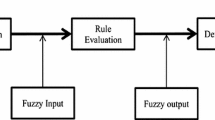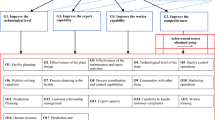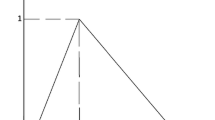Abstract
In the collaborative production environment of manufacturing tasks, the evaluation of enterprise technical capability in advance has a direct impact on the high-performance collaboration between the supplier and the demander of production tasks. In order to solve the problem of efficiency and accuracy in the past evaluation methods, this paper applies the adaptive neuro fuzzy inference system (ANFIS) to the field of enterprise technical capability evaluation for the first time, and proposes an improved hybrid intelligent model SFAHP-ANFIS-PSO based on fuzzy theory. The model takes the four key indexes which have the deepest impact on enterprise technical capability evaluation as the input variables of the model, and the input data are evaluated by ANFIS with high accuracy. Spherical fuzzy analytic hierarchy process (SFAHP) calculated the weight of each evaluation index to preprocess the ANFIS model. Particle swarm optimization algorithm (PSO) continuously optimized the model parameters in the training process, shortened the model training time, improved the evaluation efficiency, and further improved the accuracy of the evaluation results. The experimental results show that the SFAHP-ANFIS-PSO model has high convergence speed and accuracy of results, and can be used to evaluate the technical capability of enterprises with high efficiency and high accuracy.
Access provided by Autonomous University of Puebla. Download conference paper PDF
Similar content being viewed by others
Keywords
- Technical Capability Evaluation
- ANFIS
- Spherical Fuzzy Analytic Hierarchy Process
- Particle Swarm Optimization
1 Introduction
As knowledge becomes more and more specialized and decentralized, more enterprises choose to achieve complementary advantages and resource sharing through good cooperation with other enterprises [1]. High-performance collaboration maximizes the benefits of all stakeholders [2]. In collaborative networks, the in-depth study of the relevant factors affecting collaboration performance is of great significance for optimizing the selection of collaboration partners and improving the collaboration efficiency between enterprises. In recent years, domestic and foreign researchers have widely mentioned the importance of enterprise technical capability on collaboration performance in the fields like collaborative supplier selection and evaluation, collaborative innovation performance and collaborative result performance evaluation [3,4,5]. Therefore, how to evaluate the technical capability of enterprises is an extremely important problem. Enterprise technical capability evaluation is a decision problem with great uncertainty or fuzziness. In previous research on capability evaluation, a two-stage approach is often adopted. Firstly, key indicators for the evaluation problem are determined, followed by the use of different evaluation methods to obtain evaluation results. Commonly used evaluation methods include questionnaire survey, multi-criteria decision method, fuzzy comprehensive evaluation method, Back Propagation (BP) Neural Network, etc. Most of these evaluation methods are characterized by strong subjectivity, low accuracy of evaluation results, complicated calculation and low efficiency of evaluation process. BP neural network introduces intelligent algorithms into the evaluation process, but BP neural network has high requirements for data samples and parameter Settings. From a mathematical perspective, it is highly prone to getting trapped in local extrema and suffers from slow convergence speed. In addition, the ability of BP neural networks to handle uncertainty problems is inadequate.
In this paper, an improved hybrid intelligent model SFAHP-ANFIS-PSO based on fuzzy theory is proposed to evaluate the technical capability of enterprises accurately and efficiently. The SFAHP-ANFIS-PSO model combines neural network and fuzzy reasoning, quantifies the technical capability of enterprises based on fuzzy rules, and effectively solves the evaluation of uncertainty problems. To further enhance the efficiency and accuracy of the assessment results, the SFAHP algorithm [6] is used to calculate the weights of evaluation indicators. Preprocessing is performed on the model before training, and the PSO algorithm [7] is utilized to optimize the model parameters during the training process.
2 Related Work
In the field of capability evaluation, reference [8] aims at the maturity evaluation of intelligent manufacturing capability in the chair industry, proposes a multi-level evaluation index system, and uses the analytic network process (ANP) and SD software to complete the maturity evaluation of industrial intelligent manufacturing capability. Reference [9] addresses the evaluation of technological innovation capabilities in Chinese prefabricated construction companies. They propose an evaluation indicator system and utilize information entropy to determine the weights of the evaluation indicators. Finally, they quantitatively assess the technological innovation capabilities of the companies using Gray Relational Analysis (GRA). Reference [10] combines BP neural networks with the Firefly Algorithm and Sparrow Search Algorithm in the field of intelligent manufacturing capability maturity assessment. Aiming at improving enterprise performance and venture capital management, reference [11] studied the positive impact of optimizing supply chain technology innovation and venture capital on enterprise performance improvement, and proposed an enterprise performance evaluation index system. Reference [12] proposed a supplier evaluation method, which takes factors such as cost and enterprise technical capability as evaluation criteria, and uses expert scoring method to quantify qualitative indicators. Previous research methods rely on strong subjectivity in the evaluation process, the calculation process is complex, and the ability to deal with uncertain problems is insufficient. These methods have resulted in lower accuracy of assessment results and low efficiency in the evaluation process. ANFIS [13] has been widely applied to various evaluation and prediction problems and has demonstrated strong advantages in handling uncertainty. Reference [14] proposed four hybrid neural network models for spatial prediction of wildfire probability. The four models combined ANFIS with metaheuristic optimization algorithms GA, PSO, SFLA and ICA respectively. Reference [15] proposed an ANFIS-PNN-GA model to predict the air overpressure caused by blasting, in which the GA algorithm was utilized to optimize the ANFIS-PNN structure and improve the model efficiency. Reference [16] developed prediction models for compressive strength (CS) of ordinary concrete (NC) and high-performance concrete (HPC) using a combination of ANFIS and Grey Wolf Optimization (GWO) algorithm. The results demonstrated that the hybrid approach of ANFIS and GWO effectively improved the performance of the models and enhanced the accuracy of predicting CS.
In summary, the evaluation of technological capabilities in enterprises requires an evaluation method that is efficient, accurate, and capable of handling uncertainty or ambiguity. The combination of ANFIS and intelligent optimization algorithm can solve a variety of evaluation and prediction problems. Therefore, this paper proposes a SFAHP-ANFIS-PSO model for high-efficiency and high-accuracy evaluation of enterprise technical capability.
3 Implementation of the Enterprise Technological Capability Evaluation Model
3.1 Enterprise Technical Capability Evaluation Problem
The evaluation of technological capabilities in enterprises is a systematic evaluation process that assesses their strength, potential, and other aspects in the field of technology. When evaluating the technological capabilities of manufacturing enterprises, factors such as technical personnel, research and development capabilities, and technological infrastructure need to be considered to determine key evaluation indicators. In the actual production environment, each indicator may have a different impact on the evaluation results of technological capabilities. Based on this, scientific methods are used to analyze and calculate the data of each indicator, leading to the final evaluation results. In the context of collaborative networks and supply-demand relationships, the evaluation results of technological capabilities in enterprises can help demand-side enterprises understand the technical strength of the supply-side enterprises before cooperation. It facilitates the evaluation of the feasibility and reliability of collaboration, thereby ensuring the successful completion of high-performance collaborative processes.
3.2 Determine the Evaluation Index and Index Weight
Evaluation Index.
Based on the characteristics of manufacturing enterprises, expert experience and an analysis and summary of previous relevant literatures, this paper has determined the main factors for considering enterprise technical capability, including the number of senior technical engineers, the number of product patents, the proportion of R&D investment, and the degree of technology intensity.
Determine Index Weights Based on SFAHP.
The impact of different indexes on the evaluation of enterprise technical capability varies. This paper combines expert opinions with spherical fuzzy analytic hierarchy process to determine index weights. An index weight evaluation model based on SFAHP [10] is designed. The combination of spherical fuzzy set and traditional AHP in the model allows decision makers to express their uncertainty in the decision-making process through a nine-level spherical fuzzy scale, which effectively improves the scientific and accuracy of the evaluation results.
3.3 Construct the Improved Hybrid Intelligent Model SFAHP-ANFIS-PSO
Feasibility Analysis of ANFIS for Technical Capability Assessment.
ANFIS is a hybrid fuzzy inference system that combines neural networks with fuzzy logic. FIS transforms the fuzzy human experience and knowledge into the rule base of the system, which maps the nonlinear relationship between a set of inputs and outputs by using the past experience. Neural network makes ANFIS have the ability of self-learning, which determines that even without enough prior experience to construct the rule base of ANFIS, based on reasonable membership function setting, a set of rules that approximate the provided data set can be generated by learning. Based on the above advantages, ANFIS can effectively simulate the reasoning process of experts when dealing with imprecise problems related to assessing technological capabilities in enterprises. By learning from historical data of technological capability assessments, ANFIS is capable of capturing the expertise and knowledge inherent in the data. Using evaluation indicator data as input to the model, ANFIS transforms the input data into membership degrees of different fuzzy sets. Through rule operations, it ultimately maps to a specific value representing the technological capability of the enterprise.
Preprocess the ANFIS Model.
The ANFIS model has a five-layer network hierarchy, in which the adjustable parameters are in the first layer and the fourth layer. The parameters of Layer1 are all the membership function parameters, called the premise parameters, and the consequence parameters of the model are included in Layer4. This paper uses the evaluation index weights obtained by SFAHP method to preprocess all consequence parameters of the model. The index weights obtained by SFAHP combined with expert experience are much closer to the optimal solution of consequence parameters compared to random numbers. Preprocessing can effectively improve the evaluation accuracy and convergence speed of the model.
Construct the SFAHP-ANFIS-PSO Model.
Particle Swarm Optimization (PSO) algorithm is an intelligent optimization algorithm that finds the optimal solution through the cooperation and information sharing between individuals in the swarm. The algorithm is simple and easy to understand and implement, which has strong global search ability to avoid falling into local optimal solution.
In this paper, PSO algorithm is applied to ANFIS model optimization, and an improved hybrid intelligence model, SFAHP-ANFIS-PSO, was constructed (Fig. 1) to assess the technical capabilities of enterprises quantitatively. In the construction process of the SFAHP-ANFIS-PSO model, the model parameters are preprocessed using the SFAHP algorithm to calculate the weights of the indicators. Then, leveraging the advantages of the PSO algorithm, the model continuously searches for the global optimal solution for all adjustable parameters, leading to model updates. Ultimately, the model achieves optimality in terms of convergence speed and assessment result accuracy. The pseudo-code of the SFAHP-ANFIS-PSO model construction algorithm is shown in Algorithm 1.

SFAHP-ANFIS-PSO Evaluate Enterprise Technical Capability.
The SFAHP-ANFIS-PSO model takes four indicators as input data: the number of senior technical engineers in the enterprise, the number of product patents, the proportion of research and development investment, and the technological intensity. The overall evaluation process of the model consists of five hierarchical steps. Firstly, fuzzy membership assignment: For each input variable in the model, a corresponding number of fuzzy sets and their optimized membership functions are defined. This step determines the degree of membership for the input data in the fuzzy sets. Then, rule triggering strength calculation: Based on the obtained membership degrees from the previous step, the triggering strength of each evaluation rule is calculated. The number of rules is determined by multiplying the number of fuzzy sets for each input variable. Then, normalization of rule triggering strengths: The triggering strengths of each rule are normalized to ensure their consistency and comparability. completed optimal linear function. The output of each rule is then calculated by optimizing the completed optimal linear function. Finally, the final enterprise technical capability score is obtained by summing the output of each rule.
4 Experimental Results
To verify the superiority of the proposed model in this paper, MAE and RMSE were selected as performance parameters to quantitatively evaluate the model performance. The SFAHP-ANFIS-PSO model and the ANFIS-PSO model were compared from two aspects: model convergence speed and evaluation result accuracy. The program for the proposed model is implemented using the Python programming language, specifically version 3.8.0. The execution environment is set as follows: 16 GB of memory and the Windows 10 operating system. For the experimental setup, the parameters are as follows: the population size is set to 50, the number of iterations is set to 300, and each input variable has 4 fuzzy sets. The experimental comparison results are shown in Table 1 and Fig. 2.
As shown in Table 1, both SFAHP-ANFIS-PSO and ANFIS-PSO models can achieve high accuracy evaluation of enterprise technical capabilities. Among them, the error of the evaluation results of SFAHP-ANFIS-PSO is significantly smaller. The highest evaluation accuracy on the training and test datasets is (RMSE = 0.0199 and MAE = 0.1260) and (RMSE = 0.0381 and MAE = 0.1744). In terms of convergence speed, Fig. 2 reflects that the technical capability evaluation models based on ANFIS all have extremely fast convergence speed. The ANFIS-PSO model converges after about 160 iterations, and the SFAHP-ANFIS-PSO model converges after about 60 iterations thanks to the preprocessing of SFAHP.
5 Conclusion
In order to achieve high efficiency and precision evaluation of enterprise technical capability, this paper proposes a SFAHP-ANFIS-PSO model for enterprise technical capability evaluation. Firstly, four key evaluation indexes of enterprise technical capability were determined as the input parameters for the model. Then, the SFAHP-ANFIS-PSO model is constructed to complete the evaluation of technical ability. By utilizing ANFIS's ability to convert human experiential knowledge into fuzzy logic and its efficient self-learning capability, input data can be transformed into membership degrees of different fuzzy sets that closely resemble human experience. This enables efficient rule learning to take place. The SFAHP is used to calculate the weight of the evaluation indexes for model preprocessing, and the intelligent optimization algorithm PSO is used to optimize the model. The optimal solution of the model parameters is constantly searched in the training process to further improve the convergence efficiency of the model and the accuracy of the evaluation results. The experimental results show that the SFAHP-ANFIS-PSO model converges after about 60 iterations, which greatly improves the evaluation efficiency. After the validation data set test, the results show that the model evaluation results have extremely high accuracy, and the evaluation accuracy is (RMSE = 0.0381 and MAE = 0.1744).
References
Ansell, C., Gash, A.: Collaborative governance in theory and practice. J. Public Admin. Res. Theory 18(4), 543–571 (2007)
Choi, I., Moynihan, D.: How to foster collaborative performance management? Key factors in the US federal agencies. Public Manag. Rev. 21(10), 1538–1559 (2019)
Prashanth, K.D., Parthiban, P., Dhanalakshmi, R.: Evaluation of the performance and ranking of suppliers of a heavy industry by TOPSIS method. J. Sci. Ind. Res. 79(2), 144–147 (2020)
Haleem, A., Khan, S., Luthra, S., Varshney, H., Alam, M., Khan, M.I.: Supplier evaluation in the context of circular economy: a forward step for resilient business and environment concern. Bus. Strateg. Environ. 30(4), 2119–2146 (2021)
Zhou, J., Liu, Z., Li, J., Zhang, G.: The effects of collaboration with different partners: a contingency model. IEEE Trans. Eng. Manage. 68(6), 1546–1557 (2021)
Kutlu, G.F., Kahraman, C.: A novel spherical fuzzy analytic hierarchy process and its renewable energy application. Soft. Comput. 24(6), 4607–4621 (2020)
Kennedy, J., Eberhart, R.: Particle swarm optimization. In: IEEE International Conference on Neural Networks, pp. 1942–1948 (1995)
Wang, W., Wang, J., Chen, C., Su, S., Chu, C., Chen, G.: A capability maturity model for intelligent manufacturing in chair industry enterprises. Processes 10(6) (2022)
Dou, Y., Xue, X., Wang, Y., Xue, W., Huangfu, W.: Evaluation of enterprise technology innovation capability in prefabricated construction in China. Constr. Innov. 22(4), 1059–1084 (2021)
Shi, L., Ding, X., Li, M., Liu, Y., Ahmad, M.: Research on the capability maturity evaluation of intelligent manufacturing based on firefly algorithm, sparrow search algorithm, and BP neural network. Complexity, 1–26 (2021)
Wang Z., Lu, J., Li, M., Yang, S., Wang, Y., Cheng, X.: Edge computing and blockchain in enterprise performance and venture capital management. Comput. Intell. Neurosci. 2914936 (2022)
Tuzkaya, G.: An intuitionistic fuzzy Choquet integral operator based methodology for environmental criteria integrated supplier evaluation process. Int. J. Environ. Sci. Technol. 10(3), 423–432 (2013)
Jang, J.S.R.: ANFIS: adaptive-network-based fuzzy inference system. IEEE Trans. Syst. Man Cybern. 23(3), 665–685 (1993)
Jaafari, A., Zenner, E.K., Panahi, M., Shahabi, H.: Hybrid artificial intelligence models based on a neuro-fuzzy system and metaheuristic optimization algorithms for spatial prediction of wildfire probability. Agric. For. Meteorol. 266–267, 198–207 (2019)
Harandizadeh, H., Armaghani, D.J.: Prediction of air-overpressure induced by blasting using an ANFIS-PNN model optimized by GA. Appl. Soft Comput. 99(1), 106904 (2021)
Golafshani, E.M., Behnood, A., Arashpour, M.: Predicting the compressive strength of normal and high-performance concretes using ANN and ANFIS hybridized with Grey Wolf Optimizer. Constr. Build. Mater. 232, 117266 (2020)
Acknowledgements
This work was supported in part by the National Key R&D Program of China under Grant No. 2020YFB1707900 and 2020YFB1711800; the National Natural Science Foundation of China under Grant No. 62262074, U2268204 and 62172061; the Science and Technology Project of Sichuan Province under Grant No. 2022YFG0159, 2022YFG0155, 2022YFG0157.
Author information
Authors and Affiliations
Corresponding author
Editor information
Editors and Affiliations
Rights and permissions
Copyright information
© 2023 The Author(s), under exclusive license to Springer Nature Switzerland AG
About this paper
Cite this paper
Liu, T., Ding, X., Jiang, Y., Hu, D. (2023). A Hybrid Intelligent Model SFAHP-ANFIS-PSO for Technical Capability Evaluation of Manufacturing Enterprises. In: Yang, X., et al. Advanced Data Mining and Applications. ADMA 2023. Lecture Notes in Computer Science(), vol 14179. Springer, Cham. https://doi.org/10.1007/978-3-031-46674-8_46
Download citation
DOI: https://doi.org/10.1007/978-3-031-46674-8_46
Published:
Publisher Name: Springer, Cham
Print ISBN: 978-3-031-46673-1
Online ISBN: 978-3-031-46674-8
eBook Packages: Computer ScienceComputer Science (R0)






